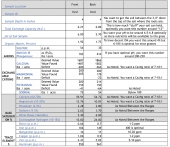




Our Microgreens: http://www.microortaggi.it




Iterations are fine, we don't have to be perfect
My 2nd Location:Florida HardinessZone:10 AHS:10 GDD:8500 Rainfall:2in/mth winter, 8in/mth summer, Soil:Sand pH8 Flat
 1
1




"People may doubt what you say, but they will believe what you do."




Todd Parr wrote:I'm pretty sure you already know the answer, but you can do what I did. Pick an area, plant a few different things in it. Pick an area close to it, pile on a ton of compost and amendments, cover the top with a nice layer of woodchips, and plant a few different things in it. Leave them this year to grow. Then next year, go back to wheeling in tons of stuff.
 1
1




Todd Parr wrote:...Then next year, go back to wheeling in tons of stuff.
 I was hoping the easy way would work out, but it really didn't. There was no comparison between planting in my hard clay soil without amendments, and the areas that I added lots of compost and wood chips, or in a lots of areas, just wood chips. My best area is a place I had a load of woodchips dumped and I left them for a couple of years. You can easily push a pitch fork into the ground under the woodchips all the way to the handle, whereas in the "undeveloped" areas, you can hardly break the surface with a fork.
I was hoping the easy way would work out, but it really didn't. There was no comparison between planting in my hard clay soil without amendments, and the areas that I added lots of compost and wood chips, or in a lots of areas, just wood chips. My best area is a place I had a load of woodchips dumped and I left them for a couple of years. You can easily push a pitch fork into the ground under the woodchips all the way to the handle, whereas in the "undeveloped" areas, you can hardly break the surface with a fork."People may doubt what you say, but they will believe what you do."




"Permaculture is a philosophy of working with, rather than against nature; of protracted & thoughtful observation rather than protracted & thoughtless labour; & of looking at plants & animals in all their functions, rather than treating any area as a single-product system."-Bill Mollison









Our Microgreens: http://www.microortaggi.it




Theoretically position 1 is more correct. But in the real world is not so easy to obtain. So realistically position 2 is more correct.William James wrote:
Anyway, I'm more interested in the theoretical basis for the two different theories and if one is "more true" than the other of if it's just a matter of who you believe.
William
"Permaculture is a philosophy of working with, rather than against nature; of protracted & thoughtful observation rather than protracted & thoughtless labour; & of looking at plants & animals in all their functions, rather than treating any area as a single-product system."-Bill Mollison





 1
1




"The rule of no realm is mine. But all worthy things that are in peril as the world now stands, these are my care. And for my part, I shall not wholly fail in my task if anything that passes through this night can still grow fairer or bear fruit and flower again in days to come. For I too am a steward. Did you not know?" Gandolf
 2
2





|
I think I'll just lie down here for a second. And ponder this tiny ad:
Homestead Pigs Course
https://permies.com/wiki/365748/Homestead-Pigs
|


